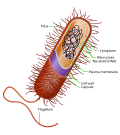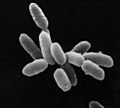A halophile (from the Greek word for 'salt-loving') is an extremophile that thrives in high salt concentrations. In chemical terms, halophile refers to...
22 KB (2,705 words) - 23:57, 27 May 2024
halotolerance and is a portion of many words: Halobacteria Haloclasty Halophile Halophyte Halo (disambiguation) This disambiguation page lists articles...
306 bytes (60 words) - 14:32, 2 March 2015
Dunaliella salina is a type of halophile unicellular green algae especially found in hypersaline environments, such as salt lakes and salt evaporation...
12 KB (1,413 words) - 07:00, 13 May 2024
Sea salt evaporation pond at Walvis Bay. Halophile organisms giving a red colour....
14 KB (1,447 words) - 13:41, 30 June 2024
in height, most of the rest are cactus, with some mangroves and other halophile plants. Many plants are rainfall sensitive, with most trees and shrubs...
164 KB (19,716 words) - 23:19, 12 August 2024
macronutrients. Due to the high salinity of HLF moromi, only anaerobic halophiles can survive in the medium. Also, the 15–30 °C (59–86 °F) temperature range...
74 KB (8,492 words) - 09:17, 8 July 2024
Halomonas organivorans is a halophile able to degrade aromatic compounds. It's considered a potentially useful bacteria for decontamination of polluted...
2 KB (181 words) - 02:28, 9 November 2021
Halocline – Stratification of a body of water due to salinity differences Halophile – organism that thrives in high salt concentrations List of bodies of...
7 KB (729 words) - 10:19, 15 August 2024
rod-shaped, Gram-positive, motile, spore-forming bacterium. A moderate halophile, this species was isolated in 2008 from water samples taken from a highly...
1 KB (118 words) - 11:33, 3 May 2024
increase to the point that salt-loving microorganisms begin to thrive. Such halophile organisms include some cyanobacteria that make their own food with photosynthesis...
12 KB (1,321 words) - 01:41, 7 August 2024
conditions, such as high temperatures (thermophiles) or high salinity (halophiles). Many archaea grow as plankton in the oceans. Symbiotic prokaryotes live...
44 KB (4,770 words) - 11:49, 31 July 2024
archaea are members of four main physiological groups. These are the halophiles, thermophiles, alkaliphiles, and acidophiles. These groups are not comprehensive...
156 KB (16,493 words) - 15:57, 9 August 2024
"Purification and characterization of aspartate aminotransferase from the halophile archaebacterium Haloferax mediterranei". The Biochemical Journal. 278...
19 KB (2,115 words) - 13:27, 22 July 2023
growth and reproduction in the presence of highly salted solutions, called halophile or "salt-lover", were tested for survival using salts commonly found on...
206 KB (19,996 words) - 08:48, 22 August 2024
limestone sea cliffs on the southern corners of Sazan are home to numerous halophile species such as lotus cytisoides and limonium anfractum. The forests of...
17 KB (1,663 words) - 01:37, 7 July 2024
temperatures. – Temperatures as high as 130 °C (266 °F), as low as −17 °C (1 °F) Halophiles such as Halobacterium salinarum (an archaean) thrive in high salt conditions...
73 KB (7,743 words) - 17:24, 25 August 2024
Marinobacter daqiaonensis (category Halophiles)
Sun, X (December 2011). "Marinobacter daqiaonensis sp. nov., a moderate halophile isolated from a Yellow Sea salt pond". International Journal of Systematic...
2 KB (157 words) - 20:11, 22 November 2023
of an archaeon was performed in 1971, when the RNAP from the extreme halophile Halobacterium cutirubrum was isolated and purified. Crystal structures...
41 KB (4,799 words) - 19:34, 17 April 2024
halide, halieutic, halite, halochromic, halochromism, halogen, halomancy, halophile, halophyte, oxohalide, thermohaline hal-, -hel- breathe Latin halare,...
1 KB (1,336 words) - 06:14, 16 April 2024
would present difficulties for most lifeforms. On Earth, organisms called halophiles exist that thrive in extremely salty conditions, though not in dark, cold...
285 KB (30,121 words) - 02:00, 27 August 2024
Halocline – Stratification of a body of water due to salinity differences Halophile – organism that thrives in high salt concentrations Hypersaline lake –...
9 KB (1,129 words) - 06:19, 14 March 2024
proteins. Most animals and fungi are examples of chemoheterotrophs, as are halophiles. Iron-oxidizing bacteria are chemotrophic bacteria that derive energy...
9 KB (829 words) - 02:51, 16 May 2024
"Net Charges of the Ribosomal Proteins of the S10 and spc Clusters of Halophiles Are Inversely Related to the Degree of Halotolerance". Microbiol. Spectr...
65 KB (7,279 words) - 23:36, 24 August 2024
Haloarchaea (category Halophiles)
distinguish them from halophilic bacteria. These microorganisms are among the halophile organisms, that require high salt concentrations to grow, with most species...
29 KB (2,962 words) - 08:29, 31 May 2024
highly acidic conditions, but many archaea live in mild environments. Halophiles, organisms that thrive in highly salty environments, and hyperthermophiles...
12 KB (1,293 words) - 00:44, 25 July 2024
Salinirubellus salinus is an halophile archaeal species. It was first isolated from a marine solar saltern in Zhejiang Province in China. It is the only...
1 KB (79 words) - 16:07, 11 February 2023
similar to those known on Earth could not occur; too salty, only extreme halophiles could survive in that environment. In 2010, a model proposed by Richard...
130 KB (12,826 words) - 21:38, 20 August 2024
Kobayashi, T.; Kimura, B.; Fujii, T. (10 March 2000). "Strictly anaerobic halophiles isolated from canned Swedish fermented herrings (Surströmming)" (PDF)...
24 KB (2,598 words) - 20:14, 15 August 2024
lowering the pH and turning the plate yellow. The salt is to select for halophiles; organisms that cannot withstand a high salt content are unable to grow...
19 KB (1,999 words) - 00:02, 4 August 2024
Shiladitya DasSarma (section Halophiles)
widely known to have been instrumental in the foundation of the fields of halophile and extremophile research. In early work (1980's), he discovered mobile...
14 KB (1,429 words) - 15:59, 17 December 2023





















